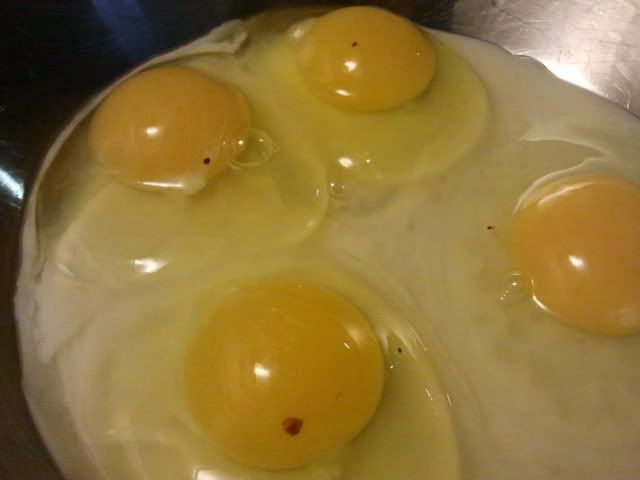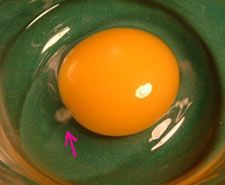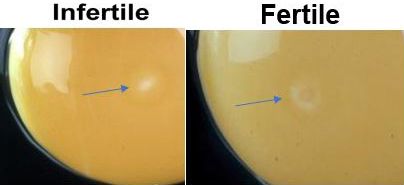The egg has been described as nature’s perfect food. It contains many important nutrients in nearly ideal profiles. When cost is considered from the nutrient value perspective, no other food can beat the egg. Over the years, eggs have been criticized by different groups. After scientific study and investigation, these assertions have been refuted, and egg consumption per capita has returned to high levels (United Egg Producers 2024). Nevertheless, due to misinformation, the consuming public is sometimes skeptical and confused about many foods and products. Although the United States produces high-quality and safe food, consumer concerns and questions remain. This publication provides information to consumers of eggs and explains a few of the common consumer misconceptions about eggs.
To better understand the egg and its nutritional value, and to discuss some common misconceptions, several points need to be clarified. What is the egg really for? Why is the nutrient makeup of the egg ideal? Why have eggs been developed as a food for humans?
When you think about it, the egg is truly miraculous! A Leghorn chicken raised under modern management conditions can produce over 300 eggs by 80 weeks of age. The eggs come to the consumer in a neat little package: the eggshell. As it is being formed in the chicken over an approximately 25-hour period, the egg passes down the oviduct where it is put together: the yolk, egg whites, inner and outer shell membranes, eggshell, and bloom. The real purpose of the egg is to support the development of the chicken embryo. Thus, it must contain everything needed from the time of fertilization until several days after the chick hatches. The concentration and quality of nutrients must be excellent. This nutrient makeup makes the egg a high-quality food for humans.
Most consumers purchase eggs from the grocery store. However, some consumers purchase eggs from small backyard flocks or even own small flocks themselves. In most cases, eggs with defects are removed by commercial farms, while these eggs from small flocks often make it to the consumer. Several common consumer misconceptions are discussed at greater length below.
Blood Spots within Eggs
Consumers may find blood spots within eggs when they break open the eggshell. The misconception is that this is evidence of the presence of a chicken embryo or fertile egg. Commercial eggs are infertile, so there is no embryo developing within the egg. The blood spots occur as the yolk is released (ovulated) from the ovary of the hen. The sac of the ovary has a line where the rupture occurs which is devoid of blood vessels called the stigma. If the sac ruptures off this narrow line as the yolk is released, a small blood vessel may leak a tiny amount of blood that is then incorporated into the egg (Figure 1).

Credit: Gary D. Butcher
These eggs are usually removed during the processing stage at commercial farms and diverted for other uses such as bakeries or production of liquid eggs. However, some eggs with small blood spots will make it through processing. These blood spots pose no public health problems. They are not indicative of a disease being present and they do not affect the quality of the egg. Chickens that produce brown-shelled eggs typically produce a higher percentage of eggs with blood spots (2%–4%) than those that produce eggs with white shells (1%–2%) (Shanker 2015). If blood spots are present, it is recommended to simply remove them and to cook and enjoy your egg.
Chalazae within Eggs
These appear as cordlike structures found on the opposite poles of the egg yolk. The misconception is that this is evidence of the presence of a chicken embryo. As noted previously, commercial eggs are infertile, so chalazae are not an indicator of the presence of an embryo. Chalazae are present in all eggs. They result from the twisting of the cords of protein that make up the egg whites as the yolk passes in a spiraling manner down the oviduct of the hen. In fresh eggs, the egg white is clear and the chalazae are easier to see. The egg is superbly designed to carry out its role, which is to support the development of the chicken embryo. When humans learned how valuable of a foodstuff eggs were, chickens were domesticated and selected to produce large numbers of eggs all year long. If an embryo was present, these chalazae would serve as stabilizers or anchors on each side of the yolk. These would help to keep the yolk in the center of the egg so that the developing embryo would not be traumatized by bouncing against the eggshell. Because no embryos are present in the eggs we purchase, the chalazae serve to stabilize the yolk. The chalazae are a normal part of the egg. They do not indicate any disease or presence of an embryo (Figure 2).

Credit: Gary D. Butcher
Hormones in Eggs
The misconception is that chickens are fed hormones to produce more eggs and these hormone residues are present in the eggs. Chickens are NOT fed hormones for several common-sense reasons: 1) it is against the law; 2) it is not economical because the hormones would cost more than what the egg is worth; and 3) chickens are already producing at their genetic potential. This misconception has been circulating for many years and continues to resurface. Some may believe this myth due to the high level of egg production that occurs on farms today. However, this excellent performance can only be achieved by providing the chickens with a high-quality feed, providing a comfortable environment, controlling disease challenge, and selecting for strong and productive genetic stock.
White Spot on the Egg Yolk Surface
The misconception is that the white spot found on the surface of the egg yolk is a small embryo. On the surface of the egg yolk is a small, white, irregular spot called the blastodisc (Figure 3). This is present in all eggs laid. If a rooster is present and the egg is fertilized, the blastodisc becomes the blastoderm or developing embryo. Since no males are present and eggs are not fertile, the white spot is simply a single cell called the blastodisc. It is possible to differentiate between an infertile and fertile egg at the time the egg is laid. When the egg is infertile, the spot is a small, irregular, white clump. If the egg is fertile, the white spot will be several times larger, round in shape, and composed of approximately 35,000 to 60,000 cells at the time the egg is laid. However, this is still very tiny and would not be detected by the consumer.

Credit: Gary D. Butcher
Double Yolk Eggs
The misconception is that hens commonly produce eggs with twins. On occasion, a hen will produce an egg containing 2 or more yolks (Figure 4). These eggs are larger in size and have thin shells. These are not sold because their large size would make the eggs difficult to package. The hen must coordinate the maturation of egg yolks in her ovary. If all is synchronized, one yolk will be ready on a daily basis to be sent along its way into the oviduct to complete the process of building the egg. A hen will sometimes release 2 or more yolks at the same time by accident. These will be passed down the tract and incorporated into one eggshell. For producers who want baby chicks, having two yolks is not an advantage because the hatch rate of these “double yolk” eggs is very low. Chicks that do hatch from these eggs are weak. Thus, these eggs are not used for hatching. Many consumers like to purchase these larger eggs, which may be found at a flea market or from small flock producers. There is nothing wrong with this kind of egg from a nutritional perspective; it would be the same as eating 2 eggs.

Credit: Gary D. Butcher
Fertility of Purchased Eggs
If eggs are purchased from a small flock where roosters are present, the eggs may be fertile. The eggs may have undergone some embryo development if they are not collected on a daily basis. The misconception is that eggs for consumption are always infertile and have no embryo development. In Figure 5, the consumer purchased eggs from a small flock owner advertising “farm fresh” eggs. The eggs were not so “fresh”; both eggs were fertile, and the hens had incubated the eggs prior to collection and chilling. There is a popular misconception that a rooster must be present for the hen to lay eggs. This is not true. A rooster is only needed if fertile eggs are desired.

Credit: Gary D. Butcher
Ascarids (Roundworms) Found inside Eggs
The misconception is that chicken intestinal roundworms cannot be found inside of the egg. Many years ago, laying hens were raised on the ground and were in contact with their droppings. With this management style, intestinal parasites cycled. As the poultry industry advanced, layers were moved to cages where they were no longer in contact with their droppings, and intestinal parasites disappeared. This broke the parasite fecal-oral transmission life cycle. However, in recent years, consumer demand for cage-free eggs has increased, resulting in the reappearance of intestinal parasites in these layers. In the life cycle for the ascarid (roundworm), the adult worm produces eggs in the intestine of the chicken. These parasite eggs pass in the chicken’s droppings, undergo maturation, and are then ingested by the chicken in contact with the droppings on the floor. The parasite egg hatches, then develops into the larva and ultimately the adult, which again produces eggs and continues the direct life cycle. When large numbers of roundworms are present, on a rare occasion, larvae may accidentally migrate into the oviduct instead of the intestines. These may be incorporated into the egg (Figures 6 and 7). As long as layers are raised on the ground, this will occur on very rare occasions. It is not aesthetically pleasing, but it poses no human health risk.

Credit: Gary D. Butcher

Credit: Gary D. Butcher
Salmonella
The misconception is that Salmonella in eggs is common, is always deadly, and renders eggs dangerous to eat. In the early 1980s, Salmonella enteritidis spread through the layer industry in many parts of the world. This bacterium was unique in that it could be spread vertically from the infected hen to inside the egg. This bacterium was also shown to cause serious disease in humans who consumed uncooked eggs. However, in a layer flock infected with Salmonella enteritidis, the actual number of eggs containing Salmonella was very low and was reported to be 1 egg in every 20,000 eggs produced. This would mean that if you ate 1 egg per day from an infected flock, you would find Salmonella in the egg once every 55 years! For it to cause a problem, the egg would have to be improperly cooked. There are more than 2,400 species of Salmonella. Only a very small number among those species cause disease in humans and chickens. Salmonella enteritidis was the only Salmonella that causes human disease that could spread by true egg transmission. A national effort was made to eliminate Salmonella enteritidis from commercial layers that produce shell eggs in the United States. The effort has been successful; no cases of Salmonella enteritidis in humans from eating commercial eggs have occurred since 2012.
There is much consumer concern in the media about Salmonella. For those working in veterinary medicine, it is known that Salmonella spp. are common in the environment. Thus, finding Salmonella during laboratory investigation would usually not be a concern because these organisms are often part of the normal bacterial flora of humans and animals. However, if specific Salmonella that can cause disease in humans are found, then action is required. It is important to understand that Salmonella are common in the environment in fruits, vegetables, and meats. In some European countries, extreme and costly efforts have been taken to eliminate Salmonella. Salmonella spp. are still present, but at a lower level. In the United States, a more practical and targeted approach has been implemented to reduce Salmonella levels. In the United States, all commercial egg laying farms are routinely monitored for Salmonella enteritidis infection. If a flock is infected, the eggs cannot be sold as shell eggs for human consumption.
Reductions of Salmonella in food, coming at great costs to the consumer, strangely have not translated into reduced human infection levels. Thus, it is more logical to prevent Salmonella infections by consumer education (i.e., “Cook it and forget”). Cooking eggs and meats to 165°F kills Salmonella and other microorganisms commonly found on meats and eggs. Following basic and common-sense practices when preparing beef, pork, fish, chicken, eggs, fruits, and vegetables can help to prevent foodborne diseases.
Summary
Although eggs are an “egg-cellent” food for humans, several misconceptions about eggs persist. However, as these myths are debunked, more individuals are likely to recognize the tremendous nutritional value eggs offer. In the United States, where food is abundant, eggs are particularly valuable due to their exceptional nutrient composition. Additionally, in developing countries, eggs serve as an economical and high-quality source of nutrients. Ultimately, educating consumers about this valuable food source plays a crucial role in promoting a better lifestyle.
References
Shanker, D. 2015. "Here's why your brown eggs have more blood spots than white ones." Quartz. https://qz.com/431136/heres-why-your-brown-eggs-have-more-blood-spots-than-white-ones
United Egg Producers. 2024. "Facts & Stats: U.S. Egg Production and Hen Population." https://unitedegg.com/facts-stats/